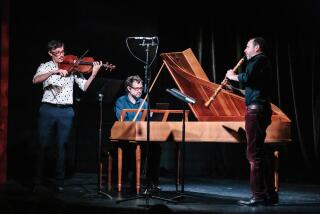Jazz Review : Acoustic Jazz Quartet Expertly Blends Sounds
- Share via
A quartet with a front line of saxophone and guitar is not a particularly common jazz combination. With a few first-rate exceptions, that is--among them the L.A. Four, Charles Lloyd’s group with John Abercrombie, and Pat Metheny’s partnership with Michael Brecker.
Add the Acoustic Jazz Quartet to the list. The locally based ensemble--with guitarist Jamie Findlay, saxophonist David Sills, bassist Zac Matthews and drummer Dean Koba--is producing music that makes the most of the intriguing sound potential in the guitar-tenor saxophone coalition. Friday night, before a full house at Rocco’s in Bel-Air, the Acoustic Jazz Quartet celebrated the release of its eponymously titled new CD with an attractive program of thoughtfully arranged, well-played music.
The pressure in this sort of instrumentation is obviously on the guitarist, who is obliged to provide harmony, melody and rhythm, sometimes individually, often collectively. And Findlay, a teacher and a performer, covered the various demands with ease. On groove-oriented pieces such as Matthews’ “Just Like It’s Always Been,” he tailored his sound and his articulation to fit the push of the rhythm; on gentler lines such as Antonio Carlos Jobim’s “Felicidade,” he took a more acoustic path, generating a subtle undercurrent of bossa nova.
Sills, one of several important young Southland saxophonists, played with the big-toned sound and harmony-defining improvising that are his stock in trade. His interaction with Findlay, filled with mellow timbres and surging melody lines, was the quartet’s defining quality.
Matthews, who co-leads the group with Findlay, played several athletic solos clearly defining his technical virtuosity. But he was equally effective as a section player, generally working well with Koba.
As a team, their only flaw was an occasional tendency to fall into repetitious rhythmic patterns, an accompaniment style that failed to match the imaginative interplay between Findlay and Sills. At their best, however, the quartet had the characteristics of a promising unit, one with considerable future potential.
More to Read
The biggest entertainment stories
Get our big stories about Hollywood, film, television, music, arts, culture and more right in your inbox as soon as they publish.
You may occasionally receive promotional content from the Los Angeles Times.










